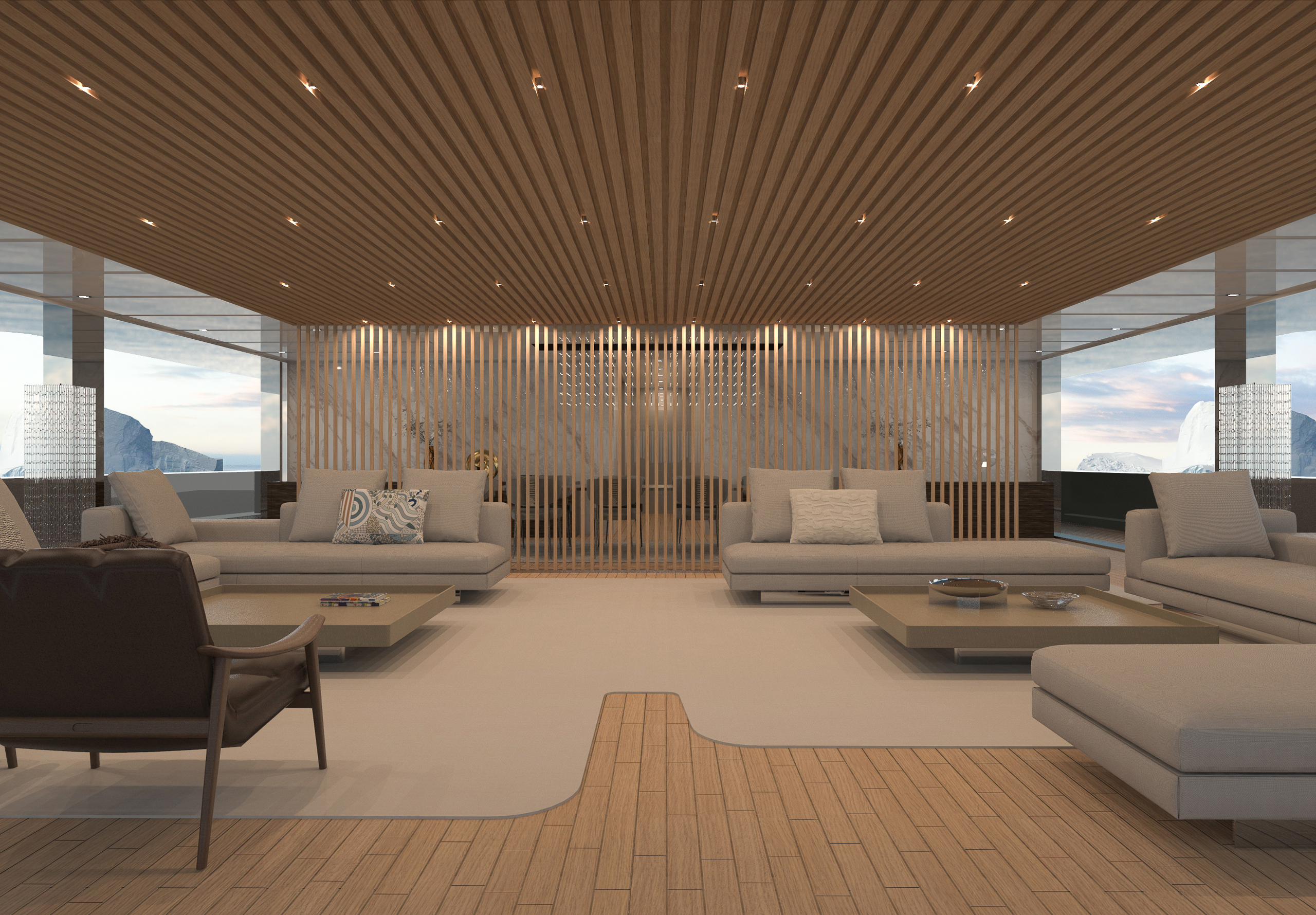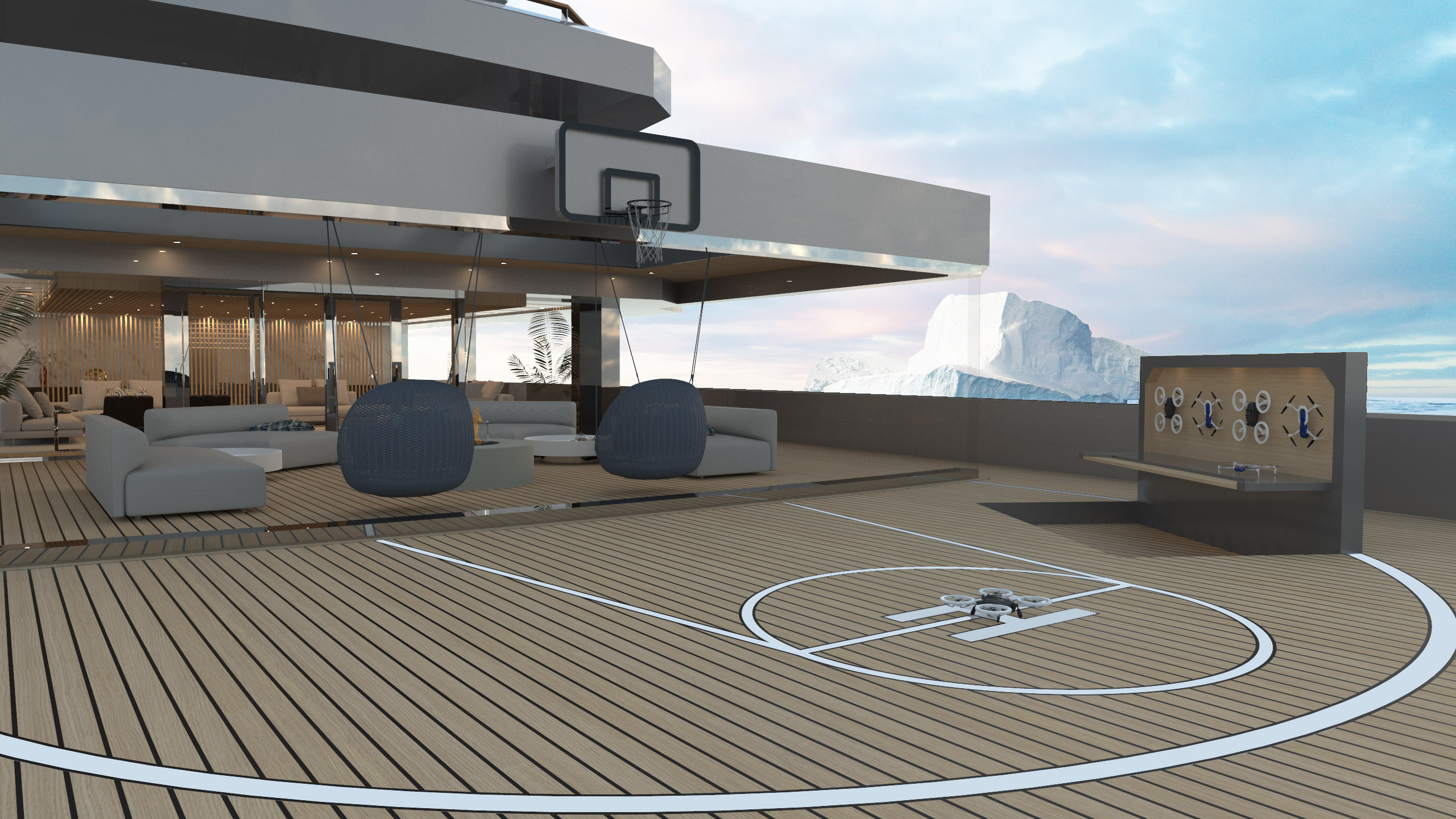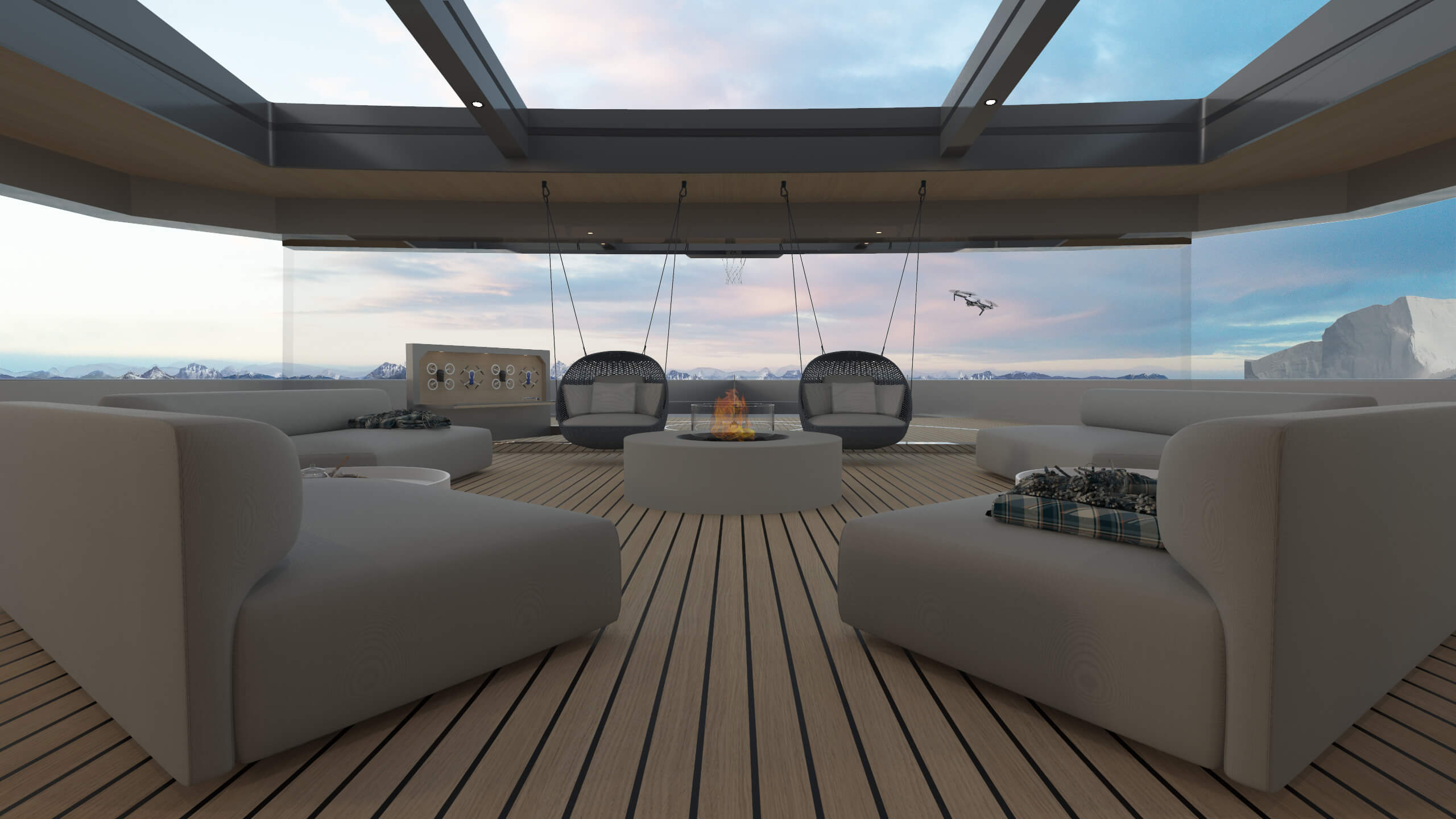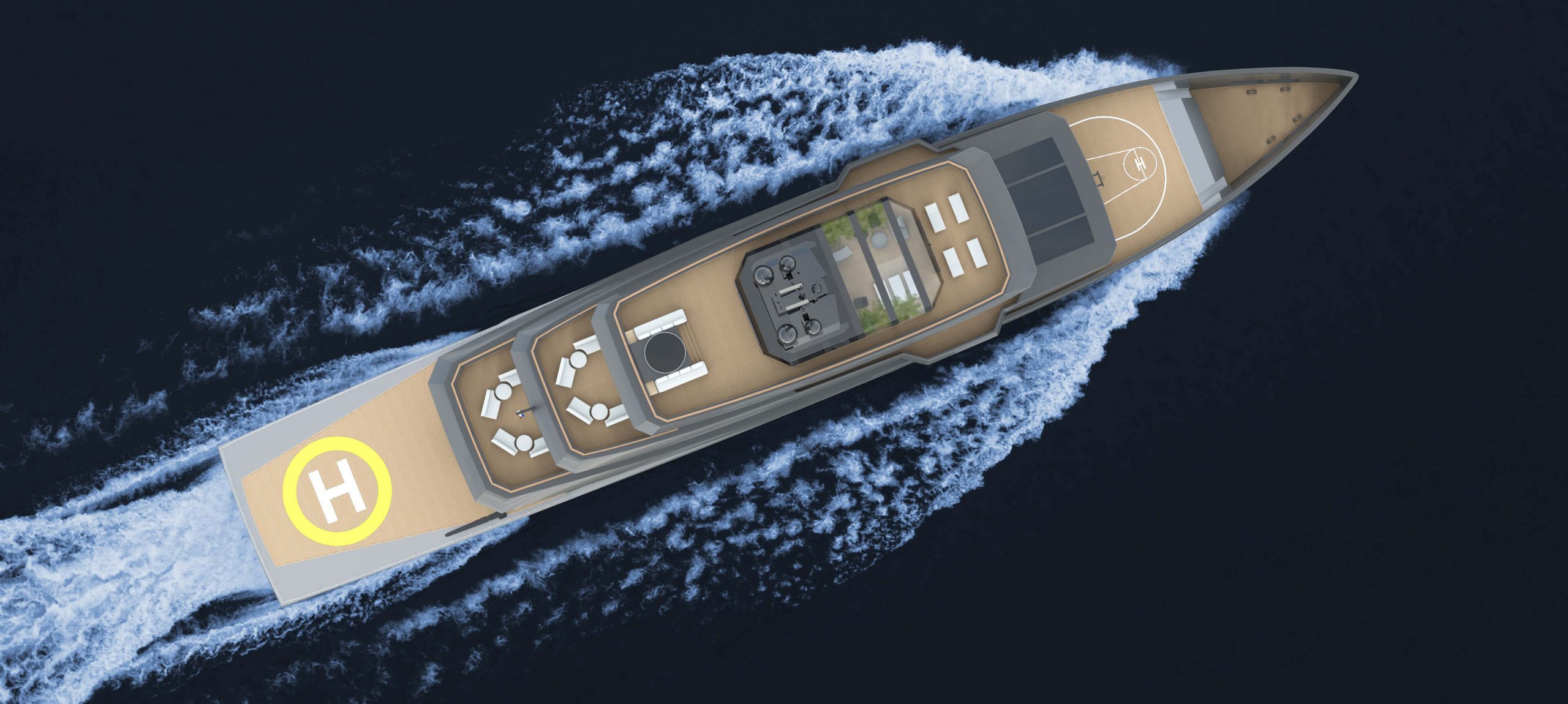An interview with a young Croatian yacht designer, Ana Čeović
Born in Zagreb, Ana Čeović (26) was named the best young yacht designer in the world, by the prestigious British magazine Boat International. In cooperation with the Oceanco shipyard, Boat International hosts a yearly design competition, gathering the attention of prominent yacht designers from all around the world.
Ana entered with her award-winning design, a 90-meter expedition yacht, which swept the competition with amazing amenities, innovative use of space and a stylized, but minimalistic, approach. The judges recognized her fresh and young style, launching her steadily, towards the very top of the yacht design industry.
Our conversation took place in a quaint cafe in Zagreb, where I could feel vigour as Ana talked passionately about yachts and yachts design.
How do you feel about receiving such an exemplary reward, from a tightly-knit circle that is the yachting industry?
It was very strange because no one from my family has ever expressed any interest whatsoever in anything remotely concerning yacht, yachting or yacht design. They worked as dentists, lawyers, economy managers… Not one tie to the sea or anything resembling an artistic approach in a career. I had a love of boats from a very young age, but still, there was a sort of fear of going into a career that was entirely unfamiliar to anyone from my family.
There was no one I could ask for help because no one from my family had any relevant or on-hand experience with my line of work. The fear of the unknown was a powerful motivator for me, at the beginning of my ‘yachting’ journey. I worked extra-hard in every aspect because I knew the only help I would receive would come from me only. But my love of boats re-assured me every step of the way: there was no faltering or second-guessing, only going forward.
I have to admit, it was hard at first, climbing through the ‘ranks’, before receiving any praises, awards or noteworthy achievements. On the other hand, my accomplishments did arrive relatively quickly; in my 26. year, I had an idea of working until my 35th birthday before anyone would start to notice my work.
After my 3rd year of college, I was pleasantly surprised when I was offered a working internship in my field of study. I thought: „Okay, so I will have to work my ass off for 5 years doing a job I hate before having a chance to do anything meaningful, and then…..MAYBE, get a chance to work in designing yachts“.
It was pure luck that things turned out the way they did – but then again, I did work hard at college, because my primary field of study did not cover yacht design. We designed mostly cars, both the interior and the exterior.
One of the main reasons we are talking today is because you recently finished an award-winning design concept of a 90-meter expeditionary yacht. Did you do the interior or the exterior?
Yes. I worked on both sides of the yacht.
Ha-ha! Interesting, because in your other interviews, my journalistic colleagues specified that you did one side or the other – not both. Surely that must be because they were oriented on you as a person, not the work you do regarding yacht design… One other thing they missed is the name of the yacht you designed?
Pheonix. But there was a mix-up regarding names. 90% of the people in the yacht-design competition I entered named the project „Pheonix“. Every yacht project has a designated name, but that name does not have to be the final name of the vessel.
One of the first sentences of the project brief was: „Let’s say we name this project Pheonix…“ and naturally, we all named our project like that because it was not clear that that was only a recommendation and not a request.

After your successful completion of the project and the subsequent award, do you feel now that you are a part of the yachting industry for sure? Have you found your niche career?
I would say that I am definitely a part of the industry, for sure. The contributing factor was also the one-year internship in Florence, where my work colleagues became like a second family to me. And it is funny to hear that these words are coming from my mouth because every time I would hear from my friends:“ My office mates are like a family to me“, I would think: “Yeah, aha, for sure…“. But that’s exactly what happened to me.
I spent 24 hours a day working and living together with my Florence colleagues, and we really became like a small family. The atmosphere was always up-to-par, really enjoyable and comfortable. So that made the year in Florence fly so fast. In the end, I have made so many contacts and formed so many relationships, that I can say – I have my foot planted firmly on the ground of the yacht design industry.
Now, for every situation I need help with, I can just call and ask for assistance from one of my numerous internship colleagues. I feel comfortable saying that I am definitely ‘part of the group’.
And IT IS a very tight-knit group of people; during the time of my London internship, I met ( to my joy and surprise ) one of my work colleagues from Turin, who I studied with. Just goes to show the interconnectedness between people in the yachting industry.
But, there is no ‘eliteness’ in the work environment. The offices I worked in did not advertise any smugness or an inflated sense of worth. The atmosphere was always correct, polite and helpful, and the dress code was non-obligatory; you could dress smart, casual or formal, but mostly jeans and shirts prevailed.
But it is another thing entirely when the client comes to the office, once every month or 3 months. Then it’s „all hands on deck“ and everybody is on their best and most formal and professional behaviour.
So, you all know when the client is due to arrive in the office…?
Yes, there is a meeting in which all the progress on the design and build of the requested yacht is demonstrated and presented to the client. During this time, everybody is very stressed and tense, and the atmosphere in the office becomes very hostile for a day. And after that period, everything returns back to normal.
You have started to describe the particularities of the yacht building process. Have you had your hands in a project that is soon to see its maiden voyage or is she on the water even as we speak?
It is impossible to talk about things like that, because I signed a non-disclosure agreement, specifying that I am not to discuss the project. But I can say that something is currently being built, somewhere in Croatia…

This brings me to my next question: Yachting in Croatia. Is this the beginning of a wonderful marriage, meaning the vast natural and logistical potential that Croatia has for harbouring superyachts, or is this the limit of what Croatia can accomplish, as to provide the typical yachting enthusiast with enough content so as to put Croatia on the map as a well-established yachting destination?
I hope that it’s just starting…
Analyzing the potential of the situation, the infrastructure in place is not nearly enough to support a larger-scale yachting endeavour…?
Croatia really has a beautiful coastline and plenty of islands to support yachting. Also, the majority of the country is tied closely to the sea, in one way or another. Wouldn’t it be nice if I, or people with similar interests as me, could study and work in the field we prefer, here in Croatia? If I could pick a specific coastal town in Croatia, where I could do my work, that would be one of the most fantastic things in the world.
Is there hope in the future?
Yes, there is, but there are many hurdles that we must overcome. It is no easy feat opening a yacht design studio in Croatia, but also finding someone to do the physical labour – that’s impossible. We don’t have anyone who would do artisan craftsmanship with wood, leather or fabrics.
Croatia has this huge problem of not being up to date with the latest technologies. I cannot find someone who would build by following my designs as I draw them. The sad thing is that Croatia does have all the skilled artisan it needs, but they all work and live abroad.
I am aware that one larger yacht was built in Croatia several years ago, before the pandemic?
It is possible that the shipyard in question is Brodosplit; I’ve heard that they are building cruisers with the backing of some Norwegian firm or something like that, I’m not entirely certain…
What’s the situation, when it comes to education and yachting in Croatia?
There is a woodworking high school in Croatia, but I don’t know the level of involvement or passion OR if they have ever invested in yacht-building… The second problem is that the kids that usually wind up at this or other similar schools, don’t have any prospects regarding a career building luxurious boats. Their passion comes second to the need of getting any kind of high school diploma…
If there were stronger ties that connected woodworkers and yacht builders in Croatia, surely something would improve.?
That would be ideal! I think that the yachting industry, in general, depends on a multitude of other factors, that are all connected in subtle or direct ways. In Italy, whatever a client thinks of, it can be built. In Croatia, it’s a lot tougher to put a build together. There is also a lack of quality high school programs that would be exclusively orientated towards yacht building, and we need the infrastructure too…
Croatia’s coastline should really be the default place to go if you want to build a yacht. People are going to Turkey to build cheaper, and they go to Italy for the design and standard. Croatia is right in the middle, in the perfect position to represent the middle of the market demand. As a part of the European Union, Croatia would represent a cheaper-to-build yacht, but with European papers. I think that the best is yet to come when talking about the Croatian yacht-building industry.

There are talks about Lurssen building a huge yacht marina in Rijeka, with several hundred dry and wet docks. Do you know anything about this?
Yes, I have heard something similar. You mentioning Lurseen reminds me of my business negotiations with them; we came into contact, but I would prefer to gather more experience in my next internship, before going to work for such a big name.
Would you consider teaching about yacht design, giving lectures to students from private universities; because public ones would not accept such an innovative curriculum as modern yacht design?
Not for now – maybe in the future, because I don’t feel comfortable enough, seeing that I am the one in need of teaching, not the other way around.
On an unrelated note – do you prefer Italian or Nordic yacht design?
Honestly, a bit of both…If I had to choose, it would be Nordic, because I can appreciate the quality of the craftsmanship, while also honouring deadlines. On the other hand, I can also relate to the soft touch of Italian yacht designers, when it comes to the smooth finish of a yacht. I find every Italian design is more pleasing to the eye than its Nordic counterpart, but behind the curtains things can sometimes become hectic, adhering to their southern mentality.
When talking about design, I DO find Sweden, Dutch and English design to be appealing, mainly due to their minimalistic tendencies i.e. a lighter and fresher approach to design. If I was building my own yacht, I would go north. But the design part would be done in Italy.
Because Italy has a rich tradition in boat building, but also their knowledge about leather treatment and application, as well as other materials is second to none.
Interesting…So, it would be theoretically possible for me to have my flat designed and furnished by a yacht design team?
Maybe. A lot of yacht design studios also offer residential and aeroplane interior design. Luca Dini is one of them. There are several firms in Italy that are used more often than others like Minotti, Paola Lenti, Armani Casa, B&B, Boffi, Flos etc for example. A high percentage of Italy-made yachts have their furniture. Or Dedar, Loro Piana, Foglizzo, Romo. These last handle the raw materials. Almost everybody I came to contact with or worked with used these firms when designing a yacht.
But then again, this is only my experience…Except for the furniture that is made to measure on yachts, all the other furniture is ordered from the outside. Don’t get me wrong, the furniture we are talking about is very well made, stylish and expensive, so there is no other choice really. But if you would look for every other item from a different firm, it would be chaos.
This streams me to my next question, regarding specific details in yacht design. Do you have maybe some idea, as to how and where will yacht design progress? What steps are to be expected? Gardens onboard yachts? Waterfalls?
The first thing that pops into my mind when talking about the future of yacht design is Sinot. They are a Dutch firm that handles conceptual designs of yachts. Mind you, they have built several contemporary yachts, which have concepts that are out of this world. Their conceptual designs are the future of yachting, as far as I’m concerned. They are like Apple of yacht design because they have no equal.
Is it going too far as to request a fireplace aboard a yacht of the future?
I guess…I did put a fireplace in my design. It is unconventional, but I could see it being used on expeditions to the Northern Sea. Wouldn’t it be nice to sit around a fire outside of your yacht, surrounded by glaciers?
Another thing regarding fireplaces is international safety rules and guidelines in yacht design. So, if you want to insure your yacht, she has to follow certain safety guidelines. If you want to start putting fireplaces, curved glass and water fountains, you will have a hard time getting your yacht properly insured.
Could you give a practical example?
Well, when I have a yacht and 100 meters to work with, I can do what I want, experiment and so forth. On smaller boats this is not the case; I don’t have room to put pools, fireplaces, or fountains, rather I need to utilize the space on disposal in the most practical manner possible.
So I don’t have big open spaces to work with or experiment in, but a list of priorities I need to satisfy – there has to be a certain amount of crew quarters, a certain number of guest accommodations, a certain number of people need to be able to sit at the dining table. After you add all these factors into the yacht equation, there is little ’empty’ room left, with which you can do as you please.
What’s your favourite place on a yacht to design?
My favourite would be the salon and the exterior spaces of the yacht.
And the worst?
The cabins. It’s not that I don’t like designing cabins, but there is very little room to work with. After you put everything you need in the cabin and add an innovative detail, there is not much left. On the other hand, the salon as a space for designing is where I feel relaxed. There is more room for design.
Are there any Croatian people that you met and are working with you or worked with you on your projects?
No.
So you are the only one?
Yes, but there was one other girl that contacted me; she wanted to go to the university I went to (Politecnico di Milano) and she asked for advice regarding enrolling and the curriculum. Last I heard, she has also finished the same school.
Who are your yacht designer role models?
Sinot, again, definitely. For breaking the barriers of classical yacht design. They are definitely a benchmark for future yacht design. I think that Sinot will eventually show themselves to be leaders in conceptual yacht design – someone that all the other yacht designers will look up to, following their example.
I can feel it in my work – when I’m designing, I think to myself: „Is this like Sinot? It should resemble Sinot more…“
This is an exciting prediction!
Yes. Bare in mind, the majority of yacht designers belong to the baby boom generation, whose main characteristics are „traditional luxury“.While the new generation of rich people do not necessarily think that marble and gold are ideals of luxury. The younger crowd definitely prefers luxurious minimalism, which will be the main driving force behind looking up to firms like Sinot. They are the ‘young bloods’ on the stage, same as the rich clientele, and they know what their clients want.
Philippe Briand, one of the yacht designers I interned for, produces some of the most beautiful yachts out there exactly because his yachts are not monstrosities on 7 floors with over-the-top details.
Every project he works on is approached individualistically – for example, every hull is drawn and made from scratch. He prefers long and thin hulls, so that a motor yacht eventually resembles a sailing yacht, seeing it more elegant that way. A real-life example is NAJIBA, my personal favourite.
It is very proportionate, nothing stands out and every feature blends in perfectly; every line is thought through… When you think about it, there are very few honestly beautiful motor yachts out there. The was majority are predominantly kitch-y.

Yachts as a sustainable concept? What are your thoughts about that?
I can see clear intentions and efforts being put into introducing sustainability to yachting as an industry. The latest Innovation Awards broadened the scale of sustainability in yachting, for example, propulsion systems that use alternative sources of fuel, or are more fuel-efficient in general.
I remember in college, I was always told that there are no ecologically acceptable motor yachts and that there will never be one. Or so I was told; I’m not an engineer so I don’t have any ideas, from that perspective, about how a motor yacht could become more ecologically acceptable, but I don’t accept the opinion of my college colleagues, that there will never BE an ecologically-acceptable motor yacht. There will surely be one; technology is advancing in huge leaps.
Like solar power?
No, because I don’t think you can power a motor yacht just on solar only. There are other energy spenders, like air-conditioning, refrigeration, lighting, garbage disposal, plumbing… There are so many factors that there is no way that solar alone would cover all the necessary energy expenditures.
Do you think that sustainability could triumph over luxury on motor yachts of the future?
Comfort will always be the top priority, something undevideable from yachting. It is possible that some segments will suffer because of sustainability, but in the long run, even that will be aestheticized. But again, the size of the yachts alone… I can’t imagine the technology that would make them ecologically acceptable.
How about planning yachts?
It could see the concept being used extensively in racing or sailing yachts. But for leisure crafts, I hardly think they would fit the norm of „comfortable“. First, it is too complicated to operate, it is dangerous due to the extreme speeds involved. I don’t see it in. This, I think, will not be the future; rather an entirely new engine system or something like that…
There were several other awards given, one of which included a design that consisted of an underwater fan that collected the energy of waves as the yachts moved, and transformed it back to electrical power, making the yacht more efficient when it comes to fuel.
The „Black Pearl“ sailing yacht is another story; it has solar cells integrated into her sails, making her double-efficient. Again mentioning Sinot, who has also received an award for a new and innovative propulsion system. Another small example would be my work in college, where I designed the yacht gym to generate electrical power from the kinetic motion of exercising.
So, something is happening regarding that theme, just slower.
There is a generation swap that is expected to happen in the yachting industry in the next couple of years. Nearly all of the current prominent yacht designers are baby boomers, so I expect there will be more saltwater gardens, green walls and alternative approaches to yacht design once the younger generation swaps with the old one.
An interesting last thought! For all our talk, I would like to thank you for putting aside some time to come and discuss yachts, yacht design and all of its broad implications with me. I wish you all the luck in your future endeavours.
It’s nothing. Thank you for the interest, and I wish you all the luck as well.
Charter Yachts
We present to you the best selling yachts for charter in 2021. Slide through these different yachts, ranging from 20 to 80 meters in length, and choose the best option for you. If you have any questions regarding yacht charter, destinations & yacht support, contact us.
VIEW ALL CHARTER YACHTS








